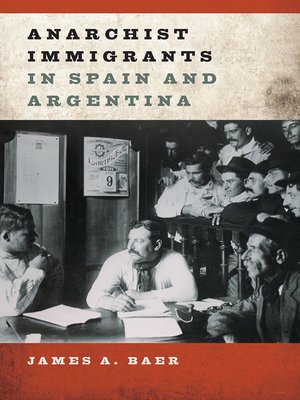
Sign up to save your library
With an OverDrive account, you can save your favorite libraries for at-a-glance information about availability. Find out more about OverDrive accounts.
Find this title in Libby, the library reading app by OverDrive.



Search for a digital library with this title
Title found at these libraries:
| Library Name | Distance |
|---|---|
| Loading... |
From 1868 through 1939, anarchists' migrations from Spain to Argentina and back again created a transnational ideology and influenced the movement's growth in each country.
James A. Baer follows the lives, careers, and travels of Diego Abad de Santillán, Manuel Villar, and other migrating anarchists to highlight the ideological and interpersonal relationships that defined a vital era in anarchist history. Drawing on extensive interviews with Abad de Santillán, José Grunfeld, and Jacobo Maguid, along withunusual access to anarchist records and networks, Baer uncovers the ways anarchist migrants in pursuit of jobs and political goals formed a critical nucleus of militants, binding the two countries in an ideological relationship that profoundly affected the history of both. He also considers the impact of reverse migration and discusses political decisions that had a hitherto unknown influence on the course of the Spanish Civil War.
Personal in perspective and transnational in scope, Anarchist Immigrants in Spain and Argentina offers an enlightening history of a movement and an era.| Cover Title Page Copyright Contents Illustrations Preface Principal Individuals Abbreviations Introduction Chapter 1. Origins of the Spanish Anarchist Movement in the Nineteenth Century Chapter 2. Anarchists and Immigration from Spain to Argentina Chapter 3. Deportations and Reverse Migration, 1902–1910 Chapter 4. The CNT and the War Years: Anarchist Rivalries and New Leadership Chapter 5. The FORA and the CNT: Transnational Anarchist Rivalries Chapter 6. Changing Political Climates and Return Migration: Abad de Santillán and the FAI in Spain Chapter 7. Abad de Santillán and the Anarchist Revolution in Spain Chapter 8. Argentine and Spanish Anarchists in the Spanish Civil War Chapter 9. Exile and Homecoming Appendix A. List of Spanish Refugees aboard the Winnipeg Appendix B. La Protesta: Prisoners in or Deported from Argentina, 1905–1906 Notes Bibliography Index |"Professor Baer's study is the obvious result of his long-term residences in Argentina, his extensive research, and particularly his interviews and correspondences with some of the major figures active in both countries. His book is a model of transnational scholarship."—Anarcho-Syndicalist Review
"Tackles the transnational story of anarchist immigrants as they moved back and forth between Spain and Argentina, demonstrating the important intellectual and personal ties many leading anarchists had with both countries. . . . A good contribution to the growing scholarship on the transnational links between leftist and revolutionary movements. Recommended."—Choice
"A valiant attempt to study the dynamic exchange of anarchist migrants between Spain and Argentina... an important contribution."—International Review of Social History
|James A. Baer is a professor of history at Northern Virginia Community College and Senior Research Fellow at the Council on Hemispheric Affairs in Washington, D.C.
James A. Baer follows the lives, careers, and travels of Diego Abad de Santillán, Manuel Villar, and other migrating anarchists to highlight the ideological and interpersonal relationships that defined a vital era in anarchist history. Drawing on extensive interviews with Abad de Santillán, José Grunfeld, and Jacobo Maguid, along withunusual access to anarchist records and networks, Baer uncovers the ways anarchist migrants in pursuit of jobs and political goals formed a critical nucleus of militants, binding the two countries in an ideological relationship that profoundly affected the history of both. He also considers the impact of reverse migration and discusses political decisions that had a hitherto unknown influence on the course of the Spanish Civil War.
Personal in perspective and transnational in scope, Anarchist Immigrants in Spain and Argentina offers an enlightening history of a movement and an era.| Cover Title Page Copyright Contents Illustrations Preface Principal Individuals Abbreviations Introduction Chapter 1. Origins of the Spanish Anarchist Movement in the Nineteenth Century Chapter 2. Anarchists and Immigration from Spain to Argentina Chapter 3. Deportations and Reverse Migration, 1902–1910 Chapter 4. The CNT and the War Years: Anarchist Rivalries and New Leadership Chapter 5. The FORA and the CNT: Transnational Anarchist Rivalries Chapter 6. Changing Political Climates and Return Migration: Abad de Santillán and the FAI in Spain Chapter 7. Abad de Santillán and the Anarchist Revolution in Spain Chapter 8. Argentine and Spanish Anarchists in the Spanish Civil War Chapter 9. Exile and Homecoming Appendix A. List of Spanish Refugees aboard the Winnipeg Appendix B. La Protesta: Prisoners in or Deported from Argentina, 1905–1906 Notes Bibliography Index |"Professor Baer's study is the obvious result of his long-term residences in Argentina, his extensive research, and particularly his interviews and correspondences with some of the major figures active in both countries. His book is a model of transnational scholarship."—Anarcho-Syndicalist Review
"Tackles the transnational story of anarchist immigrants as they moved back and forth between Spain and Argentina, demonstrating the important intellectual and personal ties many leading anarchists had with both countries. . . . A good contribution to the growing scholarship on the transnational links between leftist and revolutionary movements. Recommended."—Choice
"A valiant attempt to study the dynamic exchange of anarchist migrants between Spain and Argentina... an important contribution."—International Review of Social History
|James A. Baer is a professor of history at Northern Virginia Community College and Senior Research Fellow at the Council on Hemispheric Affairs in Washington, D.C.







